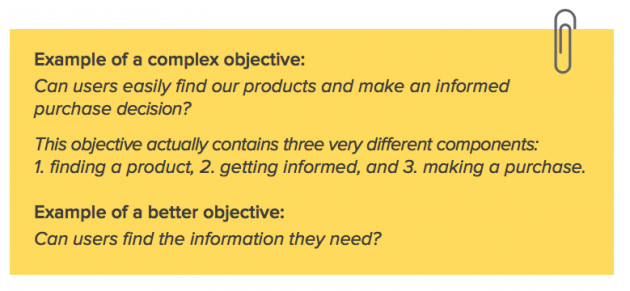
Defining UX research objectives

Today’s post on UX research objectives is an excerpt from our eBook, The complete guide to user testing websites, apps, and prototypes. Enjoy!
User feedback is the key to making any business successful—whether you’re launching an app, redesigning a website, refining product features, or making ongoing improvements to your customer experience. So how do you go about getting that feedback?
Remote user research is a fast, reliable, and scalable way to get the insights you need to improve your customer experience. Unlike traditional in-lab usability testing or focus groups, you can recruit participants and get results in a matter of hours, not days or weeks. You’re not limited by your location, schedule, or facilities. You’ll get candid feedback from real people in your target demographic in their natural environment: at home, in a store, or wherever they’d ordinarily interact with your product.
Before you begin writing a test plan for your remote study, you'll want to set a research objective and determine what you'll be studying.
Define your UX research objective
The first step toward gathering helpful feedback is setting a clear and focused objective. If you don’t know exactly what sort of information you need to obtain by running your study, it’ll be difficult to stay on track throughout the project.
Ask yourself: What am I trying to learn?
You don’t need to uncover every usability problem or every user behavior in one exhaustive study. It’s much easier and more productive to run a series of smaller studies with one specific objective each. That way, you’ll get focused feedback in manageable chunks. Be sure to keep your objective clear and concise so that you know exactly what to focus on.

As you set your objective, think about the outcomes your stakeholders will care about. You may be interested in identifying how users interact with the onboarding flow, for example, but that won’t be helpful if your team needs to identify ways to improve the monetization process. Keeping your objective front and center will help you structure your studies to gain insights on the right set of activities. It’ll also guide you in whom you recruit to participate in your study, the tasks they’ll perform, and what questions you should ask them.
Identify what you’re studying
Once you know your research objective, it’s time to determine a few specifics.
Think about what type of product you’re studying and which devices will be used to interact with it. Are you looking for feedback on a prototype? A released or unreleased mobile app? A website? If you have multiple products you want to learn about, then you’ll want to set up multiple studies—it’s best to test one product at a time so you get the most focused feedback. Keep the URL or app file handy when you set up your study. This will be where your participants will start their study.

Consider which devices and/or browsers you’ll want to include in your study. If your product is available on multiple devices, we recommend testing your mobile experience with at least as many users as your desktop experience.

Watch a demo
See how easy it is to get fast feedback on a website, prototype, design, or more in this demo.





